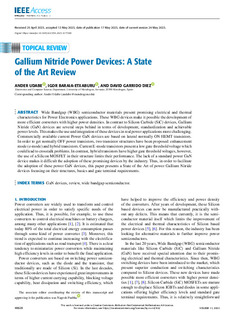| dc.rights.license | Attribution-NonCommercial-NoDerivatives 4.0 International | |
| dc.contributor.author | Udabe Zabala, Ander | |
| dc.contributor.author | Baraia-Etxaburu, Igor | |
| dc.contributor.author | Garrido, David | |
| dc.date.accessioned | 2024-02-02T08:53:14Z | |
| dc.date.available | 2024-02-02T08:53:14Z | |
| dc.date.issued | 2023 | |
| dc.identifier.issn | 2169-3536 | |
| dc.identifier.other | https://katalogoa.mondragon.edu/janium-bin/janium_login_opac.pl?find&ficha_no=173051 | |
| dc.identifier.uri | https://hdl.handle.net/20.500.11984/6224 | |
| dc.description.abstract | Wide Bandgap (WBG) semiconductor materials present promising electrical and thermal characteristics for Power Electronics applications. These WBG devices make it possible the development of more efficient converters with higher power densities. In contrast to Silicon Carbide (SiC) devices, Gallium Nitride (GaN) devices are several steps behind in terms of development, standardization and achievable power levels. This makes the use and integration of these devices in real power applications more challenging. Commercially available current Power GaN devices are based on lateral normally ON HEMT transistors. In order to get normally OFF power transistors, two transistor structures have been proposed: enhancement mode (e-mode) and hybrid transistors. Current E-mode transistors present a low gate threshold voltage which could lead to crosstalk problems. In contrast, hybrid transistors have higher gate threshold voltages, however, the use of a Silicon MOSFET in their structure limits their performance. The lack of a standard power GaN device makes it difficult the adoption of these promising devices by the industry. Thus, in order to facilitate the adoption of these power GaN devices, this paper presents a State of the Art of power Gallium Nitride devices focusing on their structures, basics and gate terminal requirements. | en |
| dc.language.iso | eng | |
| dc.publisher | IEEE | |
| dc.rights | © 2023 The Authors | |
| dc.rights.uri | http://creativecommons.org/licenses/by-nc-nd/4.0/ | |
| dc.subject | gallium nitride | |
| dc.subject | silicon carbide | |
| dc.subject | silicon | |
| dc.subject | switches | |
| dc.subject | transistors | |
| dc.subject | photonic band gap | |
| dc.subject | logic gates | |
| dc.subject | ODS 9 Industria, innovación e infraestructura | |
| dc.title | Gallium Nitride Power Devices: A State of the Art Review | |
| dc.type | http://purl.org/coar/resource_type/c_6501 | |
| dcterms.accessRights | http://purl.org/coar/access_right/c_abf2 | |
| dcterms.source | IEEE Access | |
| local.contributor.group | Sistemas electrónicos de potencia aplicados al control de la energía eléctrica | |
| local.description.peerreviewed | true | |
| local.identifier.doi | https://doi.org/10.1109/ACCESS.2023.3277200 | |
| local.source.details | Vol. 11. Pp. 48628-48650 | |
| oaire.format.mimetype | application/pdf | |
| oaire.file | $DSPACE\assetstore | |
| oaire.resourceType | http://purl.org/coar/resource_type/c_6501 | |
| oaire.version | http://purl.org/coar/version/c_970fb48d4fbd8a85 | |








